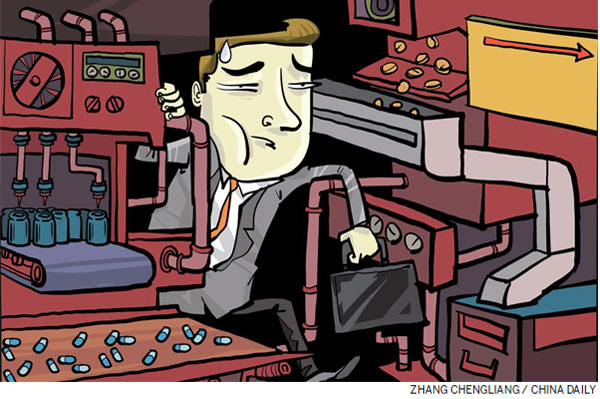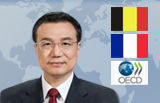Big Pharma looks to long term in China
Updated: 2015-07-03 07:19
By Seamus Grimes and Marcela Miozzo(China Daily Europe)
|
|||||||||||
While r&d potential attractive, climate made tougher by price pressure, regulatory complexities
Despite China's ambitions to promote its pharmaceutical sector, it is likely to continue to depend on significant contributions from foreign companies for some time. While the situation provides opportunities for big pharma companies to expand their markets in China, they are also hoping that offshoring research and development to China may contribute to reconfiguring their R&D models with its weak record of producing new drugs.
Drawing on interviews with pharma R&D centers in Shanghai, patent analyses and industry reports, we conclude that, despite considerable investment by big pharma companies in R&D centers in China, the investment is still in its very early stages, with Big Pharma aware that its success in the Chinese market depends on long-term investment.

With China accounting for less than 3 percent of the global revenue of most big pharma companies, the complexity and fragmentation of China's market present challenges. With the local market dominated by generic drugs, and with the state determined to reduce the cost of its burgeoning health budget, largely made up of the cost of pharmaceuticals, the opportunities for expanding market share in China will be restricted.
China's emergence as a significant force in the global pharmaceutical value chain coincides with what appears to be a critical juncture in the global pharmaceutical industry, with falling revenues and competitiveness and a possible need to reinvent the global R&D model. Among the main reasons for the falling revenues is the so-called patent cliff, with the period covering the patents of former high-revenue blockbuster drugs about to expire, as well as a dearth of new drugs, and competition from generic drug manufacturers - many of which are in less-developed countries such as India and China - becoming increasingly intense.
These pressures are also why emerging regions such as China hold out significant hope for reducing costs, for market expansion, and for reconfiguring the drug development model.
With their lower costs and also because of their potential market growth, both India and China have emerged as important offshore centers for preclinical R&D, large clinical trials and contract manufacturing. China has abundant science and technology graduates, but its pharmaceutical or biomedical ecosystem is still in the early stages, so there is a scarcity of leadership and management skills. In fact, the head of Astra Zeneca's R&D in Asia pointed out that since it takes 10 to 15 years to bring a drug to market from initial development, and because of China's shortage of experienced toxicologists, pathologists, statisticians and clinicians, it could take several decades before a pharmaceutical ecosystem is fully developed.
One area in which both countries already play a significant role is as providers of active pharmaceutical ingredients. Between 2007 and 2011, Asia's portion of the global API market went from 24 to 28 percent and is expected to reach a value of more than $50 billion by 2017.
A regulatory loophole the China Food and Drug Administration has been battling against is the ambiguous definition of chemical entities, which allows industrial-grade factories to produce and export intermediaries or chemicals that eventually end up in APIs intended for human use. Despite China's efforts to attract investment in high-end API and finished drug dosage manufacturing, Western pharma companies are reluctant to outsource these activities because it constitutes the last step in the production process and because of the difficulty in monitoring the quality of regulations in China. Yet with its huge population of potential participants in clinical trials, China presents opportunities to Big Pharma to reduce the cost of this essential aspect of development.
Part of the response of China's hospital system to the pressure on its services is to enroll patients in international clinical trials, which are profitable for hospitals.
Estimates suggest China has 114 million diabetics and perhaps as many as 493 million prediabetics. The projected program of urbanization will increase these numbers significantly. Together with the rapid aging of China's population, which will have an estimated 223 million people aged 65 and over by 2030, this will put extra pressure on the health system. The huge growth in demand for healthcare and China's expenditure in biomedicine - an estimated $71 billion in 2011 - partly explains the increased focus by Big Pharma in establishing manufacturing and R&D centers in China. According to a consultancy report, because of the uniqueness of the genomics and metabolomics of the Chinese population, this will demand new R&D investment by multinationals in Asia and will also give competitive leverage to domestic R&D entrants.
While China presents obvious opportunities for a global shift in big pharma, Western companies face a unique complexity in China, particularly with its fragmented market, with 3,700 domestic companies accounting for 75 percent of annual sales, of which 95 percent operate in the low-value generics market. They also highlight the negative effects of a three- to four-year time lag between drug registration in Europe and in China because of the critical regulatory issue requiring foreign pharma companies to conduct clinical trials in China prior to their product launches.
With 40 percent of China's healthcare budget being spent on medicine compared with 10 to 12 percent in the West, it is not surprising that big pharma companies in China are experiencing political pressure to reduce prices.
It is also no surprise the Financial Times reported that, although China is already an important market for big pharma companies, it contributes only 1 to 3 percent of global revenue for most foreign companies. Because of various government restrictions, foreign pharma companies opt for partnerships, and while increased collaboration between Big Pharma and contracting companies in China entails sharing knowledge about how to run long-term projects, they rarely involve the transfer of core intellectual property.
According to industry consultants, the failure by Chinese policymakers to create more effective regulatory infrastructure, to reform education and allow public-private partnerships to drive research are slowing the development of a more innovative environment in China for drug development.
Yet because of the growing significance of the Chinese market, multinationals such as GSK, Lily and Novartis are already moving into a more mature phase in the R&D space in China. The level of investment in China by big pharma companies to date reveals significant commitment to this market. The strategy of developing China as a major pharmaceutical R&D hub, however, is likely to be a long-term one with a view to developing significant market share in the coming 10 to 20 years, as growth opportunities in other markets decline.
Already some foreign companies have faced significant fines for being associated with the common practice of offering poorly paid Chinese doctors incentives for promoting their drugs.
Unlike in developed countries, doctors at main hospitals primarily dispense drugs in China, which can create an environment where corruption may flourish. The anti-corruption push has been focused on foreign companies, with GSK seeing a significant reduction in sales because of negative publicity. Although many acknowledge that illegal practices are widespread in the pharmaceutical sector, some suggest foreign companies are more easily targeted as part of the anti-corruption push.
While some have interpreted the crackdown on corrupt practices as a growing hostility to foreign companies, others suggest it is a relatively easy way to give a wider message to the sector, including local companies, and also to put pressure on companies to reduce costs.
Seamus Grimes is emeritus professor at Whitaker Institute, National University of Ireland, and Marcela Miozzo is a professor at Manchester Business School, University of Manchester. The views do not necessarily reflect those of China Daily.
( China Daily European Weekly 07/03/2015 page12)
Today's Top News
BP says settles US 2010 oil spill claims for $18.7b
Britain identifies all 30 British victims in Tunisian attack
BBC says to cut more than 1,000 jobs
Premier Li welcomes OECD's role in China's modernization
China is opposed to 'Grexit'
Port city seeks to increase its appeal
Aero-engine makers seek boost from major Airbus China deal
Visa policies are relaxed for visitors from China
Hot Topics
Lunar probe , China growth forecasts, Emission rules get tougher, China seen through 'colored lens', International board,
Editor's Picks

|

|

|

|

|

|






